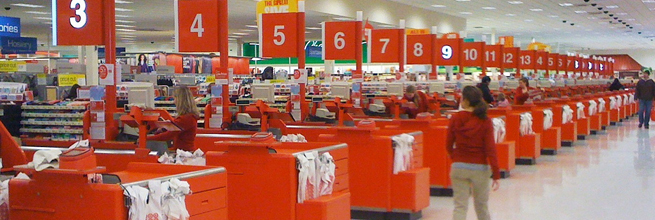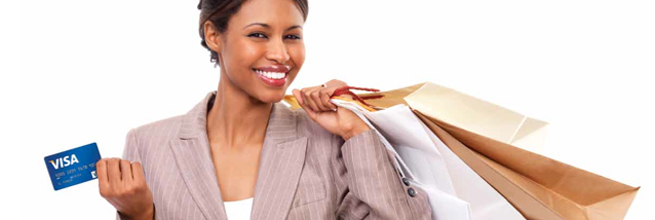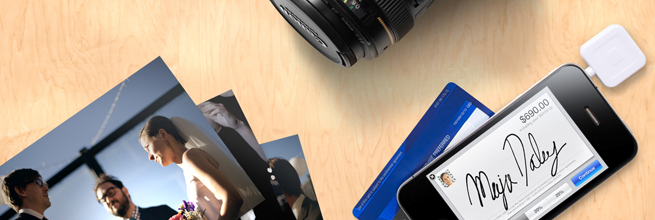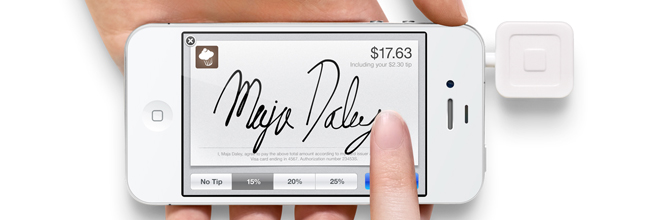I see it far too often, and each time it makes me cringe.
My favorite Thai restaurant: "Credit Card Minimum $7.50. Any less amount, 50¢ extra charge."
My hair stylist of six years: "$2 extra for a credit card transaction."
A craft show vendor: "We take Visa and Mastercard! ($3 surcharge)"
A Portland-famous Korean fusion burrito cart: "Credit Card minimum: $15"
Or—say it ain't so—the taqueria down the street from my apartment: "Cash Only. ATM available."
The Options
If you're a creative businessperson who sells your work at trade and gift shows or if you offer services to a clientele, you have a couple options on how you can take payments for your work.
Cash is great because it's cold, hard, and immediate. Counterfeit bills are rare, anyway, so there is really no risk, except for the hassle of making sure your cash box is stocked well enough to accommodate making change. This can get particularly cumbersome if you're doing a long or high-volume trade show, when the end of the day might present a box full of twenty dollar bills. If you have a physical location, you then have to lock up your money at night in a safe.
Checks used to be the norm, but there has been enough fraud with them in the last twenty years that they have become a rather risky option. Those people I do know that take them insist on local checks only, because it would seem they are easier to track down if there are any issues.
Credit and debit cards with the Visa, MasterCard, or even Discover and American Express logos have become a dime a dozen. Any person you stop on the street is likely to have two or more of these in their wallet, and they could be either debit cards tied to a checking account or lines of credit offered by what seems to be an infinite number of financial institutions.
The Benefits
Giving your customers and clients the option of using a major credit or debit card to complete a transaction with your business is an enormous point of convenience at your point of sale. And it's the right thing to do. When you look at the frequency at which we actually carry cash around with us—especially large amounts of it—and the popularity in the last two decades of using a debit card tied to a checking account, it's kind of a no brainer that we should make it as easy as possible for people to give us money.
The point of sale needs to be the smoothest, fastest, most friendly interaction because it's often the very last point of contact with your customer. And if something goes wrong or the customer feels inconvenienced, guilty, or like they did something wrong, that will influence their decision to come back for more.
Now if you're a maker whose average product price point is higher than, say, twenty dollars, you should absolutely offer this option to your potential customers. But the last thing you want to do is add an extra layer of decision, confusion, or price jump just because you are willing to take a major credit card instead of cold, hard cash.
The benefits of providing this service are pretty obvious: you typically get instant approval that ensures that the transaction is complete, there are fraud detection systems in place to minimize risk, and customers feel the freedom of being able to use the payment form of their choice. This last point is especially important around the holidays or for bigger ticket items, when cash flow might be tighter.
The Costs
Merchant services offered by banks always come with fees. They could manifest themselves as an annual account charge, a monthly equipment lease for swipe machines and devices, or most often, as a flat transaction fee plus a percentage of the transaction total (i.e. 15¢ plus 2.5%). And, if you're not careful, you could find yourself down a rabbit hole of variable fees offered by banks who are simply trying to make money in any way they can.
It's one thing for franchise chains or big box stores to offer credit card transactions or even cash back options at their terminals, as they can use their enormous weight to leverage low merchant fees and their purchasing power to install high-tech point of sale systems. But for the average small business owner, particularly people like us who are making and selling their work all on their own, that luxury isn't available, and we get stuck with what seems like exorbitant fees that start to affect our bottom line.
That's where a lot of small business merchants start to turn to checkout fees—surcharges and minimum purchase amounts for credit card transactions—as a means of offsetting the cost of offering that service. But here's the rub: you are the one offering the service, so why should your customer be punished for it? And more importantly, did you know that doing so in most cases violates your merchant agreements?
The Rules
About a year and a half ago I attended the Summit of Awesome, at which Caitlin Phillips and Willo O'Brien gave a session about mobile payment options. Caitlin mentioned something that piqued my interest: surcharging for credit card transactions is not allowed.
What?! I longed for more information, because I knew that so many small businesses surcharge for using a credit card, so I did some digging and found myself diving into the depths of Visa and Mastercard merchant agreement legalese (both links download PDFs).
It turns out that these agreements require a few things worth mentioning:
- You are required to post the accepted card logos at your point of sale. This is why merchant packages usually include the Visa/MasterCard logo stickers. Luckily they make it easy for you to do so by providing the signage.
- You are not allowed to surcharge for credit card transactions.
- You are not allowed to set a minimum transaction amount except where permitted by law.
- You are not allowed to turn down someone who offers up a card with the corresponding logo (unless that card is declined by the service).
- The price charged to a credit card must not be higher than the advertised price.
I chalk up most violations of these agreements to poor merchant education. Casual conversations with various people about the rules leads to stunned surprise—like most people and long legal documents, they are skimmed at best, but most likely ignored and blindly accepted. After all, the Mastercard Rules document alone is 360 pages long. It would take a masochist to sit down and comb through the entire thing.
The Consequences
I also learned in my research that both sites have reporting tools where consumers can actually submit a complaint about a merchant who is violating the terms of the agreement. In ten U.S. states, checkout fees are also prohibited by law and reports can be filed with the state's attorney general's office.
While I doubt every complaint is investigated, you can bet that multiple complaints against a repeat offender would raise a red flag and trigger investigation that could ultimately result in the merchant losing their ability to accept credit cards indefinitely. This could be devastating.
For those small business owners in the U.S. who are near tears right now, there is a little bit of hope. In 2010, Congress passed legislation that gave business owners some merchant fee relief, allowing us to charge up to a minimum transaction of $10 if we so choose, but no more.
The Possibilities
There are a few legal ways to get around these rules. The easiest is to offer a cash discount on your regular price. This can incentivize your customers to opt for cash, but it still creates an unfair inconsistency with what you're charging Customer A who uses a credit card and Customer B who pays with cash on hand. The point of sale should never be inconsistent or confusing.
If you are a service-based business, you can add a tip option to your receipts to allow customers the opportunity to reward you for your service. This can offset the merchant fees as well. But if you ask me, this is a stopgap. What you really need to do is look at your pricing structure and your point of sale experience.
If you sell products at a low price-point—less than $10 per item—then you should consider a minimum transaction amount for a credit card payment. Crunch the numbers and find out how much a customer needs to spend to absorb the bank fees, but remember that you can't charge a minimum of more than $10 per transaction without violating the law and your merchant agreements.
The Reality
Build your costs into your product price. If losing up to 5% of total sale is truly affecting your bottom line, then your pricing structure is wrong. If you are a product-based business, you should be profiting sufficiently off your wholesale price to begin with, and if so, that 5% off the retail price is built into your pricing buffer. If you are a service-based business owner, build that 5% into your rate or fee schedule from the get-go.
Accepting credit cards is part of the cost of doing business. If you aren't factoring this into your cost of goods sold, then you need to rethink your business plan. And if you already sell goods on a site like Etsy, you're already giving up about 5% of your transaction to both Etsy and PayPal through fees, so you're already halfway there.
The Revolution
All that said, there is a great new tool out there to help ease the burden of confusing, fluctuating merchant fees. Up until last year, most of the people I knew who sold at craft shows and gift markets would lug around "knuckle-busters"—those metal manual credit card imprint machines with that signature chunk-kachunk sound—and take cards on good faith, often processing them by phone or Internet after the show was over.
Then came Square, which is effectively revolutionizing the way that small businesses accept credit cards. Square is a merchant processing service for mobile devices that offers a free device, a free app, a free account, and a simple fee structure that leaves nothing to question. No annual charge, no monthly equipment lease, no hidden fees, just 2.75% per swiped transaction.
Unlike most merchant services, they accept Visa, MasterCard, Discover and American Express with no hassle, and they deposit your income directly to your checking account the following business day. No holding periods, no extended bank transfer times. Just easy. Oh, and they are paperless, which means you can email or SMS a receipt to your customer, complete with a GPS location where the item was purchased.
Are you sold yet? If you have an iOS or Android smartphone or tablet device already, then sign up on their website and get your card reader for free. It might just change your credit card processing life.
NOTE: I am not affiliated with Square nor are they paying me to say this. I'm simply a huge fan of the stick-it-to-the-banks revolution.
The Gist
Whatever you end up doing, build your merchant fees into your business costs. It's the right thing to do. Your point of sale needs to be as smooth and painless as possible, offering your customers the freedom to pay with their preferred method and leaving the focus on your customer service. Wow them with simplicity and they'll come back begging for more.














